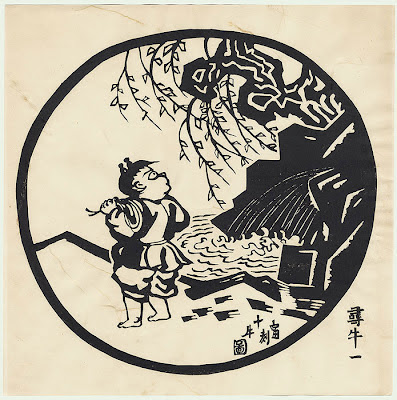Bujinkan Sandan 参段: Perceiving the Bull
From Bujinkan Santa Monica by Michael
 |
| Perceiving the Ox, digital c-print photograph by Andrew Binkley |
In the first post of this series, Bujinkan Shodan 初段: Searching for the Bull, we felt the first inspiration to begin training even though we had no idea where this may lead. In the second post, Bujinkan Nidan 弐段: Discovering the Footprints, we enjoyed getting lost in form and in henka.
Now that we've made our way to Sandan, what are we to make of it?
见牛 Perceiving the Bull
 |
| Woodblock print by 德力富吉郎 Tokuriki Tomikichirō |
I hear the song of the nightingale.
The sun is warm, the wind is mild,
willows are green along the shore -
Here no bull can hide!
What artist can draw that massive head,
those majestic horns?
Sandan brings us through a phase of hard work and study when suddenly, through no effort of our own, the bull appears! It is there then gone again. It has an ephemeral quality that makes us wonder if it even really exists.
This is discovering the self in taijutsu. All your efforts and senses come together and you open up into a new world where the bull is everywhere. And you find yourself reflected in all of your training.
We are purifying of the senses through 六根清浄 rokkon shoujou. The roku in rokkon are the six senses: sight, sound, smell, taste, touch, and mind.There are also six consciousnesses found in shiki. Any one of theses six contains the whole and is not separate. In this you may find the reward of 禄魂笑淨 rokkon shou jou as Hatsumi Sensei writes it, which suggests the purification of the senses through laughter.
All movement is an expression of the true self. The ox appears openly.
When you come to accept the non-duality of yourself and taijutsu, you relax and just begin to enjoy training. You come to class not for any purpose other than it is fun!
You may find yourself becoming a guide for other students. You don't try to teach, they naturally seek you out for guidance. And you love sharing the enjoyment of training, so the sharing is abundant.
A warning here, some dangers will appear in this stage of training. One is the tendency to boast to others of what you have seen. Another is neglecting your training and chasing the ox everywhere but in the dojo. And a third danger is ignoring or disregarding your teacher because you feel he is no longer necessary to you.
"Each thing in heaven and on earth is itself an expression of 無 Mu," while this is a nice thought it is not real training. What is the essence found in training? Unless you experience training directly you will over think it.
You have clearly seen your real self and you realize its projections are everywhere. It infuses every training experience and interaction. Once you see this, it is almost funny when you discover it in unexpected corners of your experience in the dojo.
The entire way you have been understanding taijutsu now changes completely. It is like a new beginning. You go from the empty self of 忍苦 ninku to also knowing the emptiness of the world in 法句 hokku.
Next we will move into Bujinkan Yondan 四段: Catching the Bull














